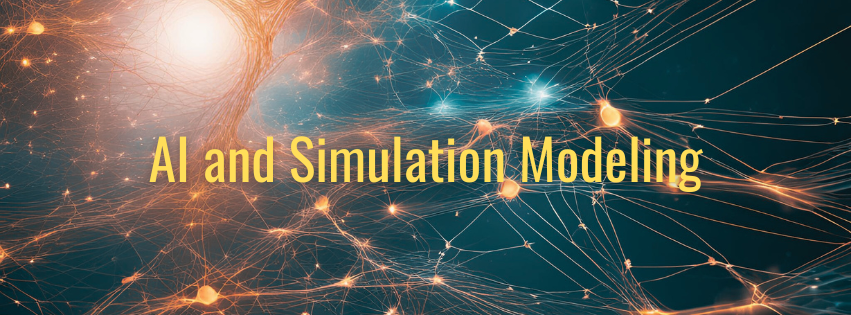Understanding Simulation Modeling and Its Relationship with Artificial Intelligence
AI mimics human intelligence via learning, reasoning, and self-correction. This article covers AI domains, simulation modeling, their overlap, and benefits.

Introduction
Artificial Intelligence (AI) is the simulation of human intelligence processes by machines, particularly computer systems. These processes include learning (acquiring information and rules for using it), reasoning (using rules to reach approximate or definite conclusions), and self-correction. AI aims to create systems that can function intelligently and independently, performing tasks that typically require human cognition.
In this article, I will describe the core domains under the AI umbrella, explore the details of simulation modeling, and examine how it intersects with AI. I will also discuss the benefits of integrating simulation modeling with AI technologies.
Key Domains of Artificial Intelligence
AI is a multifaceted field encompassing various specialized domains. Understanding these domains provides insight into how AI technologies work and their potential impact across industries. Below are some of the core or most relevant and well-known domains:
Machine Learning (ML)
Machine Learning is a subset of AI that enables computers to learn from data and improve their performance over time without being explicitly programmed. ML algorithms build models based on sample data, known as "training data," to make predictions or decisions.
- Supervised Learning: Algorithms learn from labeled datasets, making predictions based on input-output pairs. It's akin to learning with a teacher providing correct answers.
- Unsupervised Learning: Algorithms analyze and find patterns in unlabeled data, identifying hidden structures or groupings without predefined outcomes.
- Reinforcement Learning: Algorithms learn optimal actions through trial and error by receiving rewards or penalties, similar to learning by experience.
Deep Learning
Deep Learning is a specialized ML approach using neural networks with multiple layers (deep neural networks) to model complex patterns in data. It excels in image and speech recognition tasks by automatically extracting high-level features from raw input.
Natural Language Processing (NLP)
NLP focuses on the interaction between computers and human language. It enables machines to understand, interpret, and generate human language.
- Applications: Chatbots, language translation services, voice-activated assistants, sentiment analysis.
Expert Systems
Expert Systems are AI programs that emulate the decision-making ability of a human expert. They use a knowledge base of facts and rules to analyze information and provide conclusions or recommendations.
- Applications: Medical diagnosis, financial forecasting, troubleshooting guides, and decision support systems.
Robotics
Robotics combines AI with mechanical engineering, electrical engineering, and computer science to create machines capable of performing tasks autonomously or semi-autonomously. AI enables robots to process sensory information, make real-time decisions, and execute actions.
- Applications: Industrial automation, surgical robots, drones, exploration rovers.
Computer Vision
Computer Vision involves teaching machines to interpret and understand visual information from the world. By processing images and videos through deep learning models, machines can recognize objects, faces, and activities.
- Applications: Autonomous vehicles, facial recognition systems, medical image analysis, surveillance systems.
Fuzzy Logic
Fuzzy Logic deals with reasoning that is approximate rather than fixed and exact. Unlike traditional binary logic, it handles the concept of partial truth, where truth values range between entirely true and completely false.
- Applications: Climate control systems, washing machines, anti-lock braking systems, decision-making in uncertain environments.
Evolutionary Algorithms
Inspired by biological evolution, Evolutionary Algorithms use mechanisms like mutation, selection, and crossover to evolve solutions to optimization and search problems.
- Applications: Engineering design optimization, scheduling tasks, artificial life simulations, machine learning hyperparameter tuning.
Knowledge Representation and Reasoning (KRR)
KRR involves representing information about the world in a form that a computer can utilize to solve complex tasks. It enables systems to perform reasoning, draw inferences, and make decisions.
- Applications: Semantic web technologies, intelligent personal assistants, automated reasoning systems, ontology development.
Neural Networks
Neural Networks are computational models inspired by the human brain's structure and function. They consist of interconnected nodes (neurons) that work collectively to recognize patterns and solve problems.
- Applications: Handwriting recognition, speech recognition, stock market prediction, pattern and image recognition.
Simulation Modeling and Its Relationship with Artificial Intelligence
Simulation modeling involves creating digital replicas of real-world systems to study their behavior under various conditions. These models allow researchers and practitioners to analyze complex systems without the cost, time, or risk associated with experimenting on the actual systems.
- Applications: Manufacturing processes, logistics and supply chain management, healthcare systems, airport planning and management.
Tools like FlexSim enable users to build 3D models, run simulations, and analyze results to optimize system performance. FlexSim allows visualization of processes, testing changes, and data-driven decision-making to improve efficiency and productivity.
While simulation modeling is a powerful tool for system analysis and optimization, it is not traditionally classified as a standalone domain of AI. However, there is a significant overlap between simulation modeling and AI. Integrating AI techniques into simulation models enhances their capabilities, making them more intelligent, adaptive, and efficient.
Areas Where Simulation and AI Overlap
Integration of AI Techniques in Simulations
AI algorithms, such as machine learning and optimization techniques, can enhance simulation models by enabling predictive analytics, adaptive behaviors, and intelligent decision-making within the simulation environment.
- Example: Incorporating ML algorithms to predict system performance under new conditions by learning from existing data.
Agent-Based Modeling
Agent-based modeling is a simulation technique where individual entities (agents) with defined behaviors interact within a system. AI can program these agents with learning capabilities and complex decision-making processes.
- Applications: Modeling social systems, economic markets, traffic flow, crowd dynamics.
Reinforcement Learning in Simulations
Reinforcement learning can be applied within simulations to train models or agents by rewarding desired behaviors.
- Applications: Robotics and autonomous systems development, where agents learn optimal strategies through interactions within a simulated environment before real-world deployment.
Optimization and Scheduling
AI algorithms can optimize simulation parameters to find the most efficient configurations.
- Example: Using genetic algorithms (an evolutionary AI technique) to optimize resource allocation in a simulated manufacturing process.
Data Analysis and Interpretation
Simulations generate large volumes of data. AI-driven data analysis can interpret this data, identifying patterns and insights that might be missed with traditional methods.
- Applications: Detecting anomalies, predicting trends, and supporting decision-making processes based on simulation outputs.
Benefits of Using Simulation in Conjunction with AI
Enhanced Decision-Making
Combining simulation modeling with AI techniques allows for more informed decision-making. Simulations provide a risk-free environment to test scenarios, and AI algorithms can analyze outcomes to recommend optimal strategies.
Cost and Time Efficiency
Simulations reduce the need for physical prototypes or experiments, saving costs and time. AI can streamline processes by automating analysis and optimizing simulations, accelerating the development cycle.
Improved Accuracy and Predictive Power
AI algorithms can process vast amounts of data and identify complex patterns, enhancing the accuracy of simulations. Predictive models can forecast system behavior under various conditions, aiding in planning and resource allocation.
Adaptive and Intelligent Systems
Incorporating AI allows simulations to adapt to new data and evolving conditions. Intelligent agents within simulations can learn and evolve, providing more realistic and dynamic models of complex systems.
Risk Mitigation
Simulations can identify potential issues before they occur in real-world systems. AI enhances this capability by detecting subtle indicators of problems and suggesting preventive measures, thereby mitigating risks.
Conclusion
The intersection of simulation modeling and artificial intelligence represents a powerful synergy that enhances the capabilities of both fields. By integrating AI techniques into simulation models, we can create more accurate, efficient, and intelligent systems that better reflect the complexities of the real world.
This integration facilitates decision-making, cost savings, and risk mitigation across various industries. As AI continues to evolve, its role in simulation modeling will likely expand, leading to even more sophisticated and capable models.
Embracing this convergence enables organizations to leverage the full potential of both simulation and AI, driving innovation and efficiency in an increasingly complex and data-driven world. The fusion of these technologies is not just an enhancement but a necessity for tackling the challenges of modern systems and processes.
References and Resources
[1] S. J. Russell and P. Norvig, Artificial intelligence: a modern approach, Fourth edition. in Pearson series in artificial intelligence. Hoboken: Pearson, 2021.
[2] A. M. Law, Simulation modeling and analysis, Sixth edition. New York: McGraw Hill, 2023.
Commonly Known AI Domains
| AI Domain | Description and Applications |
|---|---|
| Machine Learning (ML) | Description: Involves algorithms that enable computers to learn from and make predictions or decisions based on data without being explicitly programmed. Applications: Spam detection, recommendation systems, fraud detection, predictive maintenance in manufacturing. |
| Deep Learning | Description: A subset of machine learning that uses neural networks with multiple layers (deep neural networks) to model complex patterns in data. Particularly effective for tasks like image and speech recognition. Applications: Self-driving cars, facial recognition systems, language translation, medical image analysis. |
| Natural Language Processing (NLP) | Description: Involves processing and interpreting human language to enable machines to understand, interpret, and generate human language. Applications: Chatbots, virtual assistants (e.g., Siri, Alexa), sentiment analysis, automated translation services. |
| Expert Systems | Description: AI programs that simulate the judgment and behavior of a human or organization with expert knowledge in a particular field, using a set of rules to analyze information and make conclusions. Applications: Medical diagnosis systems, financial advising, troubleshooting guides, decision support systems. |
| Robotics | Description: Combines AI with mechanical and electrical engineering to create machines capable of performing tasks autonomously or semi-autonomously. AI enables robots to process sensory information and act or react in real-time. Applications: Industrial automation, surgical robots, drones, exploration rovers. |
| Computer Vision | Description: Teaches machines to interpret and comprehend visual information from the world. Using digital images and deep learning models, machines can identify and classify objects and react accordingly. Applications: Object detection, facial recognition, autonomous vehicles, surveillance systems. |
| Fuzzy Logic | Description: Deals with reasoning that is approximate rather than fixed and exact, handling concepts of partial truth where truth values range between completely true and completely false. Applications: Climate control systems, washing machines, anti-lock braking systems, decision-making in uncertain environments. |
| Evolutionary Algorithms | Description: Include genetic algorithms inspired by biological evolution, simulating processes such as mutation, selection, and crossover to generate solutions to optimization and search problems. Applications: Engineering design optimization, scheduling tasks, artificial life simulations, machine learning hyperparameter tuning. |
| Knowledge Representation and Reasoning (KRR) | Description: Involves representing information about the world in a form that a computer system can utilize to solve complex tasks, such as diagnosing medical conditions or engaging in natural language dialogue. Applications: Semantic web technologies, intelligent personal assistants, automated reasoning systems, ontology development. |
| Neural Networks | Description: Computational models inspired by the human brain's structure and function, consisting of interconnected nodes (neurons) that work collectively to recognize patterns and solve problems. Applications: Handwriting recognition, speech recognition, stock market prediction, pattern and image recognition. |
Other Less Known AI Domains
| AI Domain | Description and Applications |
|---|---|
| Planning and Scheduling | Description: Involves algorithms that enable machines to plan sequences of actions to achieve specific goals and schedule tasks efficiently while considering constraints and resource limitations. Applications: Robotics path planning, logistics and delivery scheduling, project management software. |
| Multi-Agent Systems | Description: Studies systems where multiple intelligent agents interact or work together to solve problems beyond the capabilities of a single agent. Applications: Distributed problem-solving, simulation of social behaviors, cooperative robotics. |
| Cognitive Computing | Description: Aims to mimic human thought processes in computerized models, involving self-learning systems that use data mining, pattern recognition, and natural language processing. Applications: Healthcare diagnostics, financial advising systems, context-aware chatbots. |
| Swarm Intelligence | Description: Inspired by the collective behavior of decentralized systems like ant colonies or bird flocks, focusing on designing algorithms based on such behaviors to solve optimization problems. Applications: Network routing, optimization problems, swarm robotics. |
| Speech Recognition | Description: Deals with converting spoken language into text, enabling machines to understand and process human speech. Applications: Voice-activated assistants (e.g., Siri, Alexa), transcription services, voice control systems. |
| Affective Computing | Description: Involves the development of systems that can recognize, interpret, and process human emotions for more natural human-computer interactions. Applications: Emotional AI in customer service, adaptive learning systems, mental health monitoring tools. |
| Autonomous Systems | Description: Focuses on systems capable of performing tasks without human intervention, making decisions based on sensory input and predefined rules or learning algorithms. Applications: Self-driving cars, unmanned aerial vehicles (drones), automated trading systems. |
| Recommender Systems | Description: Predicts user preferences and provides recommendations by analyzing data patterns, enhancing user experience through personalization. Applications: E-commerce product recommendations, content suggestions on streaming platforms, social media feeds. |
| Artificial General Intelligence (AGI) | Description: Refers to the development of machines that possess the ability to understand, learn, and apply knowledge in a generalized way across a wide range of tasks, similar to human intelligence. Applications: While largely theoretical, AGI aims to create machines capable of performing any intellectual task that a human can. |
| Machine Ethics | Description: Explores the ethical considerations and frameworks necessary for AI systems, ensuring they operate within societal norms and legal boundaries. Applications: Developing ethical guidelines for AI deployment, ensuring fairness in AI decision-making, compliance with regulations like GDPR. |
| Knowledge Discovery and Data Mining (KDD) | Description: Focuses on finding patterns, correlations, and anomalies within large datasets using AI techniques to transform data into valuable information. Applications: Market analysis, fraud detection, scientific data analysis. |
| Human-Computer Interaction (HCI) | Description: Studies how people interact with computers and designs technologies that let humans interact with computers in novel ways, incorporating AI to enhance usability. Applications: Virtual reality interfaces, gesture-based controls, adaptive user interfaces. |
| Machine Perception | Description: Enables machines to interpret sensory inputs (vision, sound, touch) to understand the environment, similar to human perception. Applications: Gesture recognition, environmental sensing in robotics, surveillance systems. |
| Data Science | Description: Combines statistics, AI, and domain knowledge to extract insights from data, integral to developing AI models and interpreting their outputs. Applications: Business intelligence, healthcare analytics, predictive modeling. |
| Robotic Process Automation (RPA) | Description: Uses AI to automate repetitive, rule-based tasks typically performed by humans, enhancing efficiency and reducing errors. Applications: Automated data entry, invoice processing, customer onboarding processes. |




